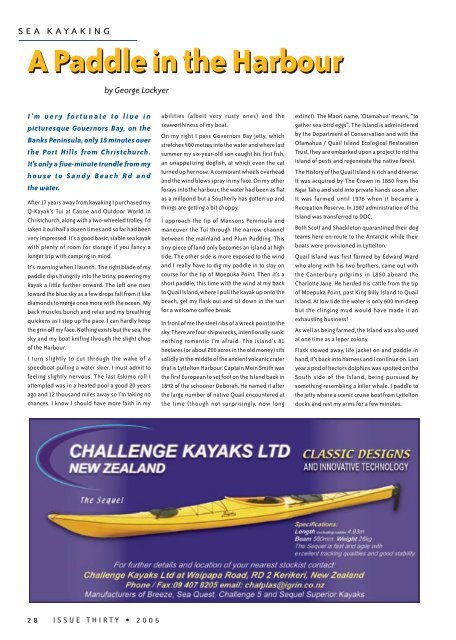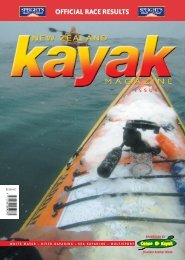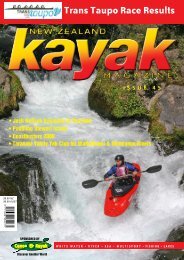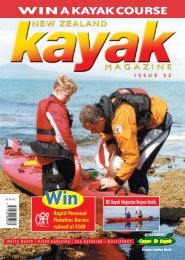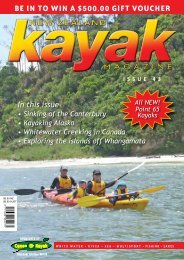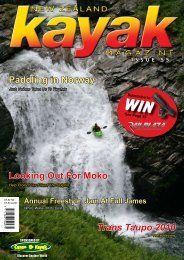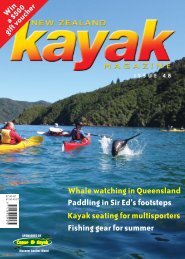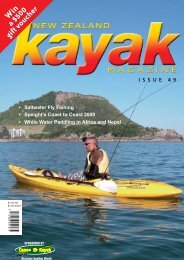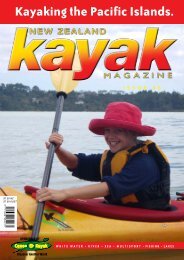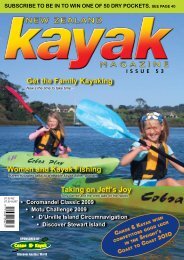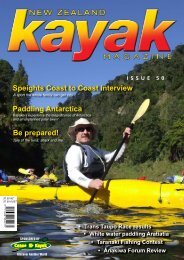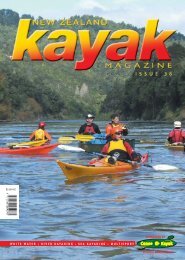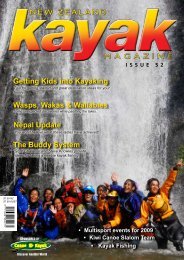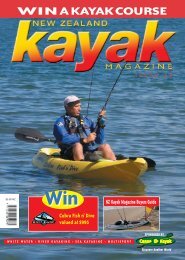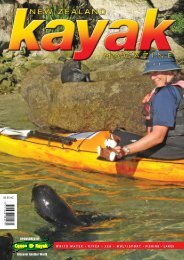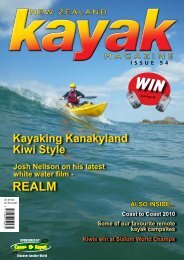C&K mag #30 sp - Canoe & Kayak
C&K mag #30 sp - Canoe & Kayak
C&K mag #30 sp - Canoe & Kayak
You also want an ePaper? Increase the reach of your titles
YUMPU automatically turns print PDFs into web optimized ePapers that Google loves.
SEA KAYAKING<br />
A Paddle in the Harbour<br />
by George Lockyer<br />
I’m very fortunate to live in<br />
picturesque Governors Bay, on the<br />
Banks Peninsula, only 15 minutes over<br />
the Port Hills from Christchurch.<br />
It’s only a five-minute trundle from my<br />
house to Sandy Beach Rd and<br />
the water.<br />
After 17 years away from kayaking I purchased my<br />
Q-<strong>Kayak</strong>’s Tui at <strong>Canoe</strong> and Outdoor World in<br />
Christchurch, along with a two-wheeled trolley. I’d<br />
taken it out half a dozen times and so far had been<br />
very impressed. It’s a good basic, stable sea kayak<br />
with plenty of room for storage if you fancy a<br />
longer trip with camping in mind.<br />
It’s morning when I launch. The right blade of my<br />
paddle dips hungrily into the briny, powering my<br />
kayak a little further onward. The left one rises<br />
toward the blue sky as a few drops fall from it like<br />
diamonds to merge once more with the ocean. My<br />
back muscles bunch and relax and my breathing<br />
quickens as I step up the pace. I can hardly keep<br />
the grin off my face. Nothing exists but the sea, the<br />
sky and my boat knifing through the slight chop<br />
of the Harbour.<br />
I turn slightly to cut through the wake of a<br />
<strong>sp</strong>eedboat pulling a water skier. I must admit to<br />
feeling slightly nervous. The last Eskimo roll I<br />
attempted was in a heated pool a good 20 years<br />
ago and 12 thousand miles away so I’m taking no<br />
chances. I know I should have more faith in my<br />
28 ISSUE THIRTY • 2005<br />
abilities (albeit very rusty ones) and the<br />
seaworthiness of my boat.<br />
On my right I pass Governors Bay jetty, which<br />
stretches 400 metres into the water and where last<br />
summer my six-year-old son caught his first fish,<br />
an unappetizing dogfish, at which even the cat<br />
turned up her nose. A cormorant wheels overhead<br />
and the wind blows <strong>sp</strong>ray in my face. On my other<br />
forays into the harbour, the water had been as flat<br />
as a millpond but a Southerly has gotten up and<br />
things are getting a bit choppy.<br />
I approach the tip of Mansons Peninsula and<br />
maneuver the Tui through the narrow channel<br />
between the mainland and Plum Pudding. This<br />
tiny piece of land only becomes an island at high<br />
tide. The other side is more exposed to the wind<br />
and I really have to dig my paddle in to stay on<br />
course for the tip of Moepuka Point. Then it’s a<br />
short paddle, this time with the wind at my back<br />
to Quail Island, where I pull the kayak up onto the<br />
beach, get my flask out and sit down in the sun<br />
for a welcome coffee break.<br />
In front of me the steel ribs of a wreck point to the<br />
sky. There are four shipwrecks, intentionally sunk:<br />
nothing romantic I’m afraid. The island’s 81<br />
hectares (or about 200 acres in the old money) sits<br />
solidly in the middle of the ancient volcanic crater<br />
that is Lyttelton Harbour. Captain Mein Smith was<br />
the first European to set foot on the Island back in<br />
1842 of the schooner Deborah. He named it after<br />
the large number of native Quail encountered at<br />
the time (though not surprisingly, now long<br />
extinct). The Maori name, ‘Otamahua’ means, “to<br />
gather sea-bird eggs”. The Island is administered<br />
by the Department of Conservation and with the<br />
Otamahua / Quail Island Ecological Restoration<br />
Trust, they are embarked upon a project to rid the<br />
island of pests and regenerate the native forest.<br />
The History of the Quail Island is rich and diverse.<br />
It was acquired by The Crown in 1850 from the<br />
Ngai Tahu and sold into private hands soon after.<br />
It was farmed until 1976 when it became a<br />
Recreation Reserve. In 1987 administration of the<br />
Island was transferred to DOC.<br />
Both Scott and Shackleton quarantined their dog<br />
teams here en-route to the Antarctic while their<br />
boats were provisioned in Lyttelton.<br />
Quail Island was first farmed by Edward Ward<br />
who along with his two brothers, came out with<br />
the Canterbury pilgrims in 1850 aboard the<br />
Charlotte Jane. He herded his cattle from the tip<br />
of Moepuka Point, past King Billy Island to Quail<br />
Island. At low tide the water is only 600 mm deep<br />
but the clinging mud would have made it an<br />
exhausting business!<br />
As well as being farmed, the Island was also used<br />
at one time as a leper colony.<br />
Flask stowed away, life jacket on and paddle in<br />
hand, it’s back into harness and I continue on. Last<br />
year a pod of hectors dolphins was <strong>sp</strong>otted on the<br />
South side of the Island, being pursued by<br />
something resembling a killer whale. I paddle to<br />
the jetty where a scenic cruise boat from Lyttelton<br />
docks and rest my arms for a few minutes.


